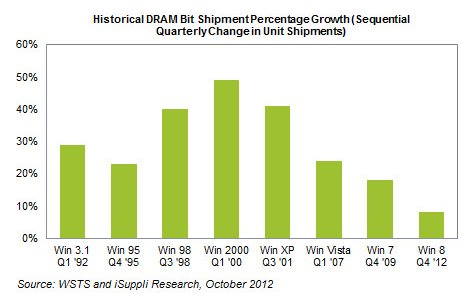
Posted on Monday, October 29 2012 @ 19:30 CET by Thomas De Maesschalck
Market research firm IHS iSuppli predicts the arrival of Windows 8 will not lead to a significant rise in DRAM demand. The firm estimates DRAM demand will increase by just 8 percent this quarter, which is significantly less than the demand surges seen with previous Windows releases.
Debuts of new PC operating systems (OS) from Microsoft Corp. always have generated double-digit percentage increases in quarterly DRAM shipments—until this year, when the rollout of Windows 8 is not expected to generate a significant rise, according to a new IHS iSuppli DRAM Market Brief Report from information and analytics provider IHS (NYSE: IHS).
Global DRAM bit shipments are expected to increase by only 8 percent in the fourth quarter compared to the third, and this lower growth number includes not only DRAM for PCs, but also in smartphones and tablets. Windows 8 is not expected to generate the kind of bump in DRAM shipments seen in the past partly because of its lean hardware requirements. Even more importantly, the arrival of Windows 8 is not likely to deliver a significant increase in PC shipments in the fourth quarter of 2012 compared to the same period in 2011.
“The release of a new Microsoft OS traditionally has been accompanied by more advanced system requirements, which then fuels growth in the DRAM market as more bits are shipped,” said Clifford Leimbach, analyst for memory demand forecasting at IHS. “However, starting with Windows 7 and continuing with Windows 8, Microsoft has taken a leaner approach with its operating systems, maintaining the same DRAM requirements as before. Meanwhile, consumers are continuing to eschew new PC purchases in the fourth quarter, with Windows 8 not expected to change this situation.”
DRAM Bonanza
The release of a new OS is traditionally accompanied by more advanced system requirements, which then fuel growth in the DRAM market as more DRAM bits are shipped out, as shown in the figure below. At such times, DRAM shipments grow because of increased orders from PC original equipment manufacturers that need to put the additional memory into their products, as stipulated by the requirements of the new OS. Many consumers also decide that the release of a new operating system represents a good time to purchase a new computer or to upgrade their memory, driving further DRAM sales.
For instance, the release of Windows 3.1 caused DRAM bit shipments to increase by 29 percent sequentially in the first quarter of 1992, compared to just a 12 percent climb in the earlier quarter. A similar heady expansion was seen with Windows 95 in light of a 23 percent advance during the fourth quarter of 1995. Prior to the surge, DRAM bit shipments had been growing on average by 11 to 14 percent in the previous four quarters.
An even bigger rise in DRAM bit shipments took place at the time of Windows 98. DRAM bit shipments rose 40 percent in the third quarter of 1998 at the time of the new OS, compared to bit shipment growth of 4 to 16 percent in the earlier four quarters.
Two of the biggest upward movements in DRAM bit shipments occurred around the time that Windows 2000 and Windows XP were introduced. Compared to their previous-quarter levels, DRAM bit shipments jumped 49 percent in the first quarter of 2000 due to Windows 2000, while DRAM bit shipments swelled 41 percent in the third quarter of 2001 because of Windows XP.
The exuberant expansion started to slow down, however, in the last two Windows operating systems. Only a 24 percent rise in DRAM bit shipments resulted with Windows Vista in the first quarter of 2007. Windows 7, which did not require more memory to operate than the previous member of the Windows line, saw a further attenuation in growth, to just 18 percent in the fourth quarter of 2009. DRAM growth at the time also was slowing perceptibly, coinciding with the start of the economic recession.
The End of the OS DRAM Boom
Now with Windows 8, scheduled for release on October 26, DRAM bit growth in the market has decelerated even more. Shipments of DRAM are expected to increase by 8 percent in the fourth quarter of 2012 —the lowest rate of growth among all Windows operating systems dating to Windows 3.1, covering a span of more than 20 years. Instead of additional DRAM for computers purely due to higher DRAM requirements, the increased uptake of the memory will be found in smartphones and tablets and refreshed PCs combined, accounting for the gain of DRAM bit shipments in the fourth quarter.
PCs No Longer Dominate DRAM Market
All told, PCs will not be as important to the overall DRAM market moving forward. PC share in the DRAM space dipped below 50 percent for the first time earlier this year, while alternative devices using DRAM—such as smartphones and media tablets—are raising their usage and DRAM market share.
As DRAM enters an era of diversified applications, the lack of a boost from a new operating system will prove less significant. And while the highs to be derived from increased DRAM bit shipments won’t be as dramatic from quarter to quarter, the lows will also be more muted because of the extenuating effects of a disparate application base, IHS believes.

